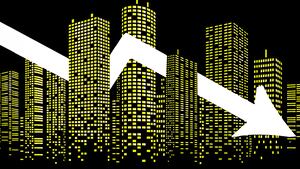The COVID-19 pandemic will be shaping how we live, work and learn about the world long after the last lockdown ends and toilet paper hoarding is done, accelerating shifts that were already underway including the dispersion of population out of the nation’s densest urban areas and the long-standing trend away from mass transit and office concentration towards flatter and often home-based employment.
Amid 20 years of fanfare about how big, dense cities are the future, the country had kept spreading out with nearly all population growth since 2010 occurring in the urban periphery and smaller cities. As a new study from Heartland Forward, where I am a senior fellow, demonstrates, both immigrants and millennials—the key groups behind urban growth—are increasingly moving to interior cities and even small towns.
The coronavirus, which has hit major American cities hardest so far, is likely to accelerate that trend.
Both cases and deaths have been overwhelmingly concentrated so far in Seattle, Los Angeles, San Francisco, Boston and New York. Gotham has been the American epicenter; dense regions seem especially susceptible to pandemics. This has also been the case in Europe. Half of all COVID-19 cases in Spain for example have occurred in Madrid while the Milan region accounts for half of all cases in Italy and almost three-fifths of the deaths.
Suburban, exurban and small-town residents are, of course, vulnerable too, and will soon share some of the cities’ pain but far less than subway riders who live in crowded apartments. The people outside big cities, for example, get around in the sanctuary of their private cars and don’t have to push elevator buttons to get to and from their residences. Most rural areas, outside of some resorts, have suffered far less, benefiting from less crowding and unwanted human contact.
Simply put, pandemics are bad for dense urban areas, particularly those that are diverse and relatively free. This has been very much the case since antiquity. The more global and vital an urban system—Rome, Alexandria, Cairo, Venice, Florence, London, Paris—the more susceptible it is to the pandemics that seem to be occurring regularly over the past two decades. Cities no doubt will recover, particularly if real estate prices continue to fall, but the pandemics limit their upward trajectory and will continue to drive people elsewhere.
In this era, the most prominent physical expression of urban greatness—once cathedrals or great public works—has been the office building and the luxury housing tower. The growth of steel and glass towers reflect the magnetic economic power of big cities. And to be sure, we still see some new ones on occasion in places like New York and Chicago, and even more so in the rising cities of East Asia and the Middle East.
Yet even before the coronavirus, large office buildings were losing their primacy. New technologies make it increasingly easy for companies to work far from the dense megacities, sparking a process that one British writer has described as “counter-urbanization.” Due in large part to technology, we use far less space per new job. In the 1990s companies used 175 square feet of space per new employee, a number that dropped to 125 in the late 2000s and barely 50 square feet today. Between 2016 and 2018, a time of robust economic growth, net demand absorption plunged from 58 million square feet to 35 million square feet.
At the same time, roughly 80 percent of new job growth has already been taking place in the suburbs and exurbs. Rather than concentrate in big cities, notes economist Jed Kolko, the share of the economy controlled by the five largest metros has declined over the past quarter-century. In many key business sectors, such as professional and business services and technology, sprawling places like Austin, Salt Lake City, Dallas-Fort Worth, Raleigh and Phoenix, as well as smaller cities like Madison, WI and Boise, grew their high-end employment far more quickly. In these circumstances massive new office and residential projects, like those being proposed for Sunnyside, Queens, seem quixotic at best.
One key driver is the accelerating trend towards working at home, as evidenced by growing web use, up between 20 to 40 percent, with much of the surge taking place during the daytime. In the United States, there had already been a declining share for transit, while telecommuting has grown rapidly, up 140 percent since 2005. Even before the current pandemic, the benefits of working remotely were apparent in terms of productivity, innovation, lower employee turnover.
Work at home, according to the census, now exceeds transit usage nationwide, accounting for well over 5 percent of the workforce; it could easily employ almost about one in four workers over time, in ways that will reshape cities. Millions of Americans who used to commute to work, whether in mind-numbing traffic or rattling subway cars, now are seeing if they can work at home efficiently. Many may find it difficult to get back to work in an office.
The future of the office may include adding office space to new homes and apartments as the late Al Toffler’s concept of the “electronic cottage” becomes ever more common. One has to believe that companies like IBM and Yahoo, which sought to ban at-home work, are busily wiping the egg from their faces.
The firms that can rely on dispersed work will benefit most while some jobs—notably in hotels, airports and theme parks—may wither for violating the new norms of “social distancing.” Yet this transition is a veritable gold mine for companies like Slack—now the fastest growing business application on record—Zoom, Skype, Google Hangouts and Microsoft Teams, all of which manage real-time collaboration on documents, spreadsheets, presentations and conversations. Other clear winners include Amazon, which is hiring 100,000 new workers, streaming entertainment services, telemedicine and online education providers.
Education until now has followed industrial age models, with learning on fixed schedules in classrooms. The experience was highly hierarchical and in-person, and, in recent years, unfathomably expensive outside of the public schools.
Even before the virus there was a strong movement to online learning. At the grade school level it included an estimated 2.5 million home-schooled students whose numbers have been growing at between 2 to 8 percent per annum. Homeschool advocates, who include many religious conservatives, claim that students, a third of whom are minorities, do considerably better in terms of achievement than their public-school counterparts with only a fraction of the public funding. Now that most public schools are online for the time being, it seems likely that some districts, particularly those concerned with costs, may seek to employ these systems more readily.
The impact on colleges could be even more profound. College debt has become a plague to the current millennial generation, and more parents find they cannot afford to pay expensive schooling. Online instruction is not always optimal, but neither is spending a fortune to sit in a lecture hall with 300 other students while interfacing only with graduate students.
In the U.S., online college courses have more than quadrupled in the last 15 years. It is an approach that works in particular for non-traditional students, such as those seeking a new career and skill. Some schools, such as Arizona State University, are now defining much of the future of mass education. The school’s president, Michael Crow, has been pushing on-line education for over a decade and today ASU offers more than 175 online degree and certificate programs serving more than 46,000 undergraduate and graduate students and learners.
There is almost no part of our society that will emerge unchanged from this moment.
One profound shift may be in how people get information as the already battered media’s response to the virus is ranked far below not just hospitals or state government, but even President Trump or Congress, according to Gallup. Rather than turning to the news, many people are going straight to the CDC or John Hopkins’ COVID-19 dashboard as a better way to access “just the facts.”
The shift to online services may be a boon to the already much-too-powerful tech oligarchs, as big companies, quasi-monopolies and chains hold oou while small businesses are wiped out by a month or two without revenue. By the time that we are done sheltering in place, expect that some of your local spots will be closed, and not all of them will be replaced.
Yet at the same time the pandemic could provide, as one British writer put it, “a social stimulus,” a reawakening of the vast apparatus of local, charitable and communal institutions.
The nature of the crisis—its shattering effects on jobs, where we work, and revenues—will force communities to rely on local resources, volunteers, churches and clubs. The new models may not be driven by oligarch funders or even governments but by grassroots assistance that has been central to the approach taken by states like Utah.
The new home-based, localized culture could even address global issues like climate change. Rather than see the solution as ever more density, a shift to people working from home, and dispersing, could prove effective as a way to reduce greenhouse gases without enforcing an agenda of greater privation, an idea embraced by some in the environmental community who see the shutdown as a “fire drill” for future actions.
Rather than a nasty era of reduced expectations, we could be on the cusp of creating a more humane and sustainable urban culture. Many primary functions—food service, media, business and professional services, finance—will operate mostly free of unwanted human contact. Rather than Le Corbusier’s super-high-density “Radiant City”, our metropolises may come to resemble Frank Lloyd Wright’s Usonia, a sprawling, low-rise, family-friendly environment.
In the end, the pandemic could lead us to rediscover the essential value of family, something that is often seen as reactionary or outdated by some progressive thinkers. Indeed, as researcher Sam Abrams notes, surveys show that it’s millennials and Gen Z who suffer most from isolation and alienation. Perhaps returning to the family home may allow them to see the advantage of this most ancient of affiliations.
Margaret Mead once remarked, “no matter how many communes anybody invents, the family always creeps back.”
In social isolation, we are not only stuck with each other, but we also learn how we depend on each other. Life in a studio apartment, or dorm room, is far less attractive in a pandemic era than being close to hearth and home.
If we learn something about what really matters, it may not make up for the current tragedies, but perhaps it will mean that our suffering will not all have been in vain.








